Changes in Spatial Distribution of Arable Land, Crop Production and Yield of Selected Crops in the EU Countries after 2004
Abstract
1. Introduction
Theoretical Background
2. Materials and Methods
3. Results
3.1. Percentage of Ploughing
3.2. Cereals Cultivation
3.3. Growing of Oilseeds
3.4. Growing of Potatoes
4. Discussion
5. Conclusions
Author Contributions
Funding
Institutional Review Board Statement
Data Availability Statement
Conflicts of Interest
Appendix A
| Country | Cereals | Oilseeds | Potatoes | ||||||
|---|---|---|---|---|---|---|---|---|---|
| 08/04 | 13/09 | 19/14 | 08/04 | 13/09 | 19/14 | 08/04 | 13/09 | 19/14 | |
| AUT | 8.1 | −10.9 | −5.6 | 24.7 | 5.5 | 6.0 | 9.2 | −16.3 | 0.1 |
| BEL | 6.2 | −4.9 | −11.0 | 19.3 | 39.2 | −49.0 | −8.9 | 4.0 | −8.1 |
| BGR | −6.0 | 46.6 | 16.8 | 38.2 | 48.7 | −6.5 | −38.4 | −19.5 | 48.8 |
| CYP | −94.3 | −8.6 | 732.4 | −33.9 | −4.2 | 45.7 | −12.6 | −12.5 | −28.6 |
| CZE | −4.9 | −4.1 | −12.9 | 8.0 | 19.9 | −24.1 | −10.7 | −28.7 | −10.7 |
| DEU | −1.9 | −4.0 | −14.8 | −3.0 | −8.2 | −53.2 | −12.8 | −17.2 | −8.7 |
| DNK | 1.6 | −10.3 | −2.8 | 34.4 | 7.9 | 2.8 | 3.9 | 1.8 | 39.0 |
| EST | 42.0 | 11.7 | 33.0 | 62.1 | 27.9 | 16.7 | −24.8 | −8.1 | −31.7 |
| ESP | −3.4 | 41.8 | 0.0 | 2.2 | 32.7 | 18.0 | −22.7 | −19.1 | −11.2 |
| FIN | 16.9 | −4.6 | −2.3 | 18.9 | −42.7 | −31.9 | 10.5 | −17.7 | 3.1 |
| FRA | −0.3 | −4.0 | −3.0 | 14.1 | −18.1 | −28.8 | −6.0 | −2.3 | 5.9 |
| GRC | 9.8 | −7.0 | −31.0 | −7.1 | −14.2 | −57.5 | −1.3 | −5.0 | −23.6 |
| HRV | 21.5 | −7.2 | 17.1 | 61.9 | 3.9 | 56.3 | 3.4 | −39.9 | 7.6 |
| HUN | 0.4 | 0.1 | −5.8 | 39.8 | 9.3 | 15.1 | −12.7 | −13.1 | −39.5 |
| IRL | −1.7 | 16.3 | −12.8 | 203.0 | 107.6 | 9.6 | −37.5 | 22.0 | −0.2 |
| ITA | −7.2 | 2.9 | −15.6 | −22.6 | −4.1 | 8.6 | −12.0 | −27.4 | −2.0 |
| LTU | 19.7 | 17.6 | 1.7 | 59.9 | 32.4 | 38.5 | −29.9 | −35.6 | −29.6 |
| LUX | 6.6 | −8.1 | −3.0 | −0.2 | −15.8 | −34.9 | −2.2 | −12.5 | −19.2 |
| LVA | 59.5 | 17.2 | 42.0 | 90.2 | 44.8 | 119.5 | 7.2 | −5.6 | −55.8 |
| MLT | 34.7 | −12.1 | −100.0 | 100.0 | 820.0 | −50.0 | −16.6 | 25.6 | −28.4 |
| NLD | 12.3 | −12.0 | −9.3 | −4.7 | −17.2 | −49.8 | −7.5 | −8.4 | −2.0 |
| POL | −6.7 | −4.6 | −10.9 | 27.7 | 6.9 | −30.1 | −25.3 | −24.9 | −15.7 |
| PRT | −4.6 | 21.8 | −17.0 | 10.1 | 49.9 | 103.9 | −28.8 | 4.2 | −9.1 |
| ROU | −31.0 | 40.5 | 37.8 | −1.5 | 68.1 | 39.1 | −13.7 | −17.8 | −25.4 |
| SWE | −5.7 | −4.9 | 6.4 | 10.7 | 6.3 | 15.6 | −12.9 | −6.0 | 3.0 |
| SVN | −0.6 | −14.0 | −1.7 | 77.8 | 45.7 | −24.5 | −41.5 | −39.9 | −31.9 |
| SVK | 8.9 | 2.4 | −12.8 | 32.4 | 2.5 | −8.0 | −35.8 | −23.9 | 2.0 |
| EU | −3.3 | 3.2 | −3.2 | 4.8 | 7.7 | −11.3 | −14.2 | −13.8 | −6.7 |
Appendix B

Appendix C
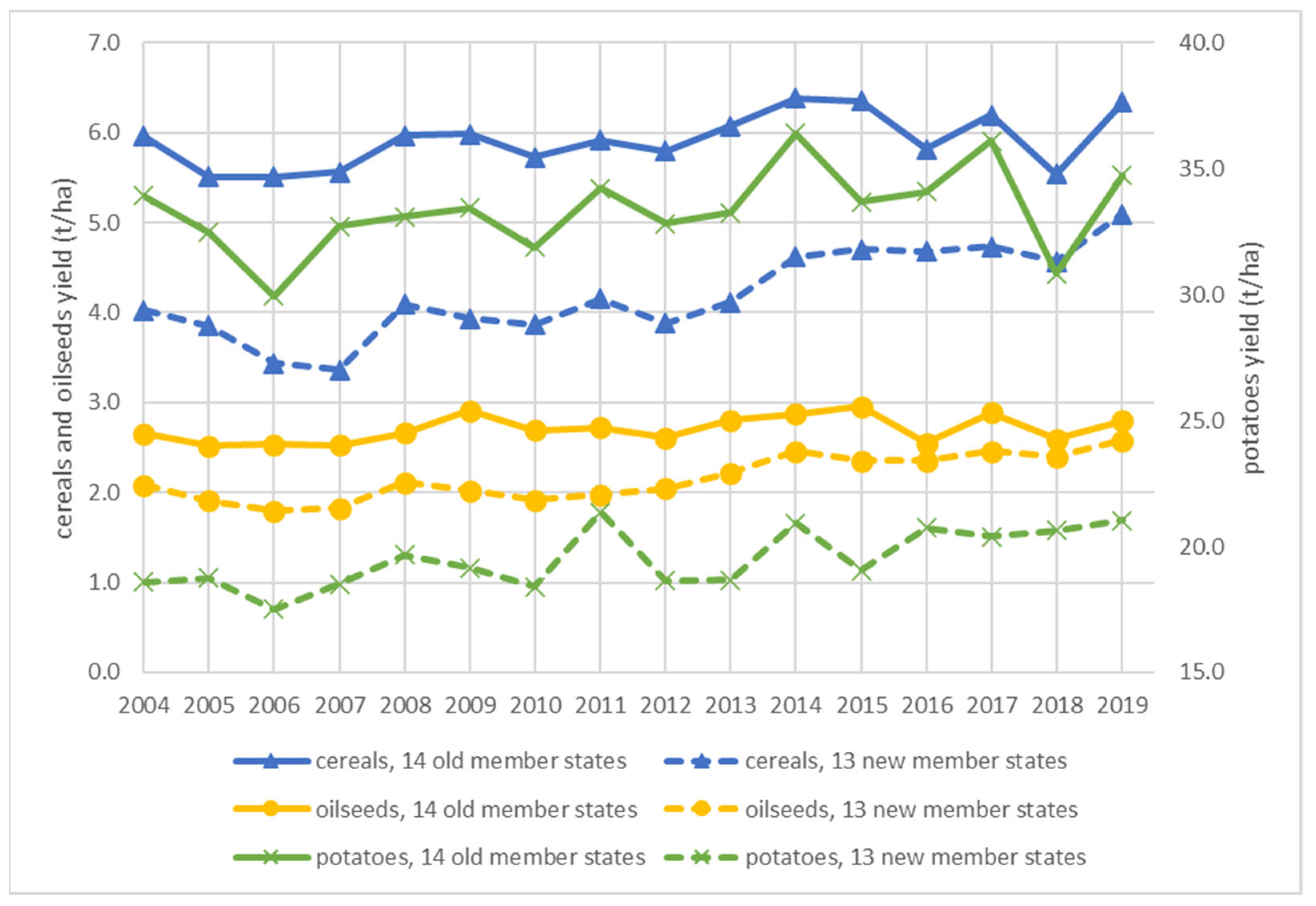
References
- FAOSTAT. Available online: https://www.fao.org/faostat/en/#home (accessed on 19 December 2021).
- Chrastinová, Z.; Krížová, S.; Zbranek, P. Comparison of production performance of agriculture in EU countries. Ekon. Poľnohospodárstva 2017, 17, 53–76. [Google Scholar]
- Némethová, J.; Rybanský, Ľ. Development Trends in the Crop Production in Slovakia after Accession to the European Union—Case Study, Slovakia. Sustainability 2021, 13, 8512. [Google Scholar] [CrossRef]
- Nowak, A. Differentiation in cereal production among Member States of the European Union. Pol. J. Agron. 2020, 40, 7–15. [Google Scholar] [CrossRef]
- Čechura, L.; Hockmann, H.; Malý, M.; Žáková Kroupová, Z. Comparison of Technology and Technical Efficiency in Cereal Production among EU Countries. Agris -Line Pap. Econ. Inform. 2015, 8, 27–37. [Google Scholar] [CrossRef]
- Simionescu, M.; Bilan, Y.; Gedek, S.; Streimikiene, D. The Effects of Greenhouse Gas Emissions on Cereal Production in the European Union. Sustainability 2019, 11, 3433. [Google Scholar] [CrossRef]
- Popescu, A.; Stoian, E.; Șerban, V. Oil Seeds Crops Cultivated Area and Production in the Eu-28–Trends and Correlations, 2008–2018. Sci. Pap. Ser. Manag. Econ. Eng. Agric. Rural. Dev. 2019, 19, 265–272. [Google Scholar]
- Cernay, C.; Ben-Ari, T.; Pelzer, E.; Meynard, J.-M.; Makowski, D. Estimating variability in grain legume yields across Europe and the Americas. Sci. Rep. 2015, 5, 11171. [Google Scholar] [CrossRef] [PubMed]
- Věžník, A.; Král, M.; Svobodová, H. Agriculture of the Czech Republic in the 21st century: From productivism to post-productivism. Quaest. Geogr. 2013, 32, 7–14. [Google Scholar] [CrossRef]
- Věžník, A.; Konečný, O. Agriculture of the Czech Republic after accession to the EU: Regional differentiation. Morav. Geogr. Rep. 2011, 19, 50–60. [Google Scholar]
- Kroupová, Z.; Trnková, G. The analysis of economic results differences of agricultural holdings specialized in plant production in the Czech Republic. J. Cent. Eur. Agric. 2014, 15, 322–334. [Google Scholar] [CrossRef]
- Kotyza, P.; Slaboch, J. Food Self Sufficiency in Selected Crops in the Czech Republic and Poland. Acta Univ. Agric. Et Silvic. Mendel. Brun. 2014, 62, 1329–1341. [Google Scholar] [CrossRef]
- Greslova, P.; Stych, P.; Salata, T.; Hernik, J.; Knižková, I.; Bičik, I.; Jeleček, L.; Prus, B.; Noszczyk, T. Agroecosystem energy metabolism in Czechia and Poland in the two decades after the fall of communism: From a centrally planned system to market oriented mode of production. Land Use Policy 2019, 82, 807–820. [Google Scholar] [CrossRef]
- Todorová, S. Bulgarian agriculture in the conditions of the EU Common Agricultural Policy. J. Cent. Eur. Agric. 2016, 17, 107–118. [Google Scholar] [CrossRef]
- Jeanneret, P.; Lüscher, G.; Schneider, M.; Pointereau, P.; Arndorfer, M.; Bailey, D.; Balázs, K.; Báldi, A.; Choisis, J.-P.; Dennis, P.; et al. An increase in food production in Europe could dramatically affect farmland biodiversity. Commun. Earth Environ. 2021, 2, 183. [Google Scholar] [CrossRef]
- Kobus, P. Changes of Level and Variability of Wheat Production in the EU Member States for the Period of 1961–2008. Econ. Sci. Rural. Dev. 2010, 21, 90–99. [Google Scholar]
- Voicilas, D.M. Cereals sector development in Romania. Ekon. Poľnohospodárstva 2018, 18, 62–73. [Google Scholar]
- Hýblová, E.; Skalický, R. Return on sales and wheat yields per hectare of European agricultural entities. Agric. Econ.–Czech 2018, 64, 436–444. [Google Scholar] [CrossRef]
- Artyszak, A. Effect of Silicon Fertilization on Crop Yield Quantity and Quality—A Literature Review in Europe. Plants 2018, 7, 54. [Google Scholar] [CrossRef]
- Pedersen, S.M.; Bizik, J.; Costa, L.D.; Coutinho, J.; Dolezal, F.; Gluska, A. Potato production in Europe–a gross margin analysis. (pp. 1–39). FOI Work. Pap. 2005, 5, 4–31. [Google Scholar]
- Kowalska, A.S.; Curkowa, K. Changes in Potato Production and Consumption in Poland in 2001–2019. Problems of World Agriculture. Sci. J. Wars. Univ. Life Sci.–SGGW 2019, 19, 46–56. [Google Scholar] [CrossRef]
- Devaux, A.; Goffart, J.P.; Petsakos, A.; Kromann, P.; Gatto, M.; Okello, J.; Suarez, V.; Hareau, G. Global food security, contributions from sustainable potato agri-food systems. In The Potato Crop: Its Agricultural, Nutritional and Social Contribution to Humankind; Campos, H., Ortiz, O., Eds.; Springer Cham: Dordrecht, The Netherlands, 2020; pp. 3–35. [Google Scholar] [CrossRef]
- Goffart, J.P.; Haverkort, A.; Storey, M.; Haase, N.; Martin, M.; Lebrun, P.; Ryckmans, D.; Florins, D.; Demeulemeester, K. Potato Production in Northwestern Europe (Germany, France, the Netherlands, United Kingdom, Belgium): Characteristics, Issues, Challenges and Opportunities. Potato Res. 2022, 65, 503–547. [Google Scholar] [CrossRef] [PubMed]
- Dachin, A. Production costs of field crops by economic size of farms in Romania. Sci. Pap. Ser. Manag. Econ. Eng. Agric. Rural. Dev. 2016, 16, 103–106. [Google Scholar]
- Gebeltová, Z. Exploitation of Agricultural land in the Czech Republic and EU Countries. AGRIS -Line Pap. Econ. Inform. 2017, 9, 33–44. [Google Scholar] [CrossRef][Green Version]
- Benešová, I.; Novotná, Z.; Šánová, P.; Laputková, A. Economic Comparison of Agricultural Sector of Eurasian Countries–Is There Any Potential for Development Through Economic Cooperation? AGRIS -Line Pap. Econ. Inform. 2016, 8, 19–31. [Google Scholar] [CrossRef]
- Bartóková, Ľ. The Position of Agriculture and Food Sector in V4 Countries. AGRIS -Line Pap. Econ. Inform. 2019, 11, 13–22. [Google Scholar] [CrossRef]
- Sobocká, J.; Šurina, B.; Torma, S.; Dodok, R. Klimatická Zmena a Jej Možné Dopady na Pôdny Fond Slovenska; Výskumný ústav pôdoznalectva a ochrany pôdy: Bratislava, Slovakia, 2005; p. 48. [Google Scholar]
- Kurdy´s-Kujawska, A.; Strzelecka, A.; Zawadzka, D. The Impact of Crop Diversification on the Economic Efficiency of Small Farms in Poland. Agriculture 2021, 11, 250. [Google Scholar] [CrossRef]
- Carter, M.R.; Cheng, L.; Sarris, A. Where and how index insurance can boost the adoption of improved agricultural technologies. J. Dev. Econ. 2016, 118, 59–71. [Google Scholar] [CrossRef]
- Smatana, J.; Macák, M. Adaptácia na zmenu klímy v poľnohospodárstve EÚ a SR (II). Naše Pole 2022, 10, 52–53. [Google Scholar]
- Liu, Y.S.; Liu, X.Q.; Liu, Z.J. Effects of climate change on paddy expansion and potential adaption strategies for sustainable agriculture development across Northeast China. Appl. Geogr. 2022, 141, 102667. [Google Scholar] [CrossRef]
- Liu, X.Q.; Liu, Y.S.; Rui, Y.; Zhang, J.; Zhao, X.Z. Evaluation of sustainable agriculture and rural development in agro-pastoral ecotone under climate change: A comparative study of three villages in the Shenfu coalfield, China. J. Rural. Stud. 2022, 93, 504–512. [Google Scholar] [CrossRef]
- Howland, F.; Le Coq, J.F. Disaster risk management, or adaptation to climate change? The elaboration of climate policies related to agriculture in Colombia. Geoforum 2022, 131, 163–172. [Google Scholar] [CrossRef]
- Zhang, J.W.; Wang, J.G.; Chen, S.B.; Tang, S.Q.; Zhao, W.T. Multi-Hazard Meteorological Disaster Risk Assessment for Agriculture Based on Historical Disaster Data in Jilin Province, China. Sustainability 2022, 14, 7482. [Google Scholar] [CrossRef]
- Kotyza, P. Are V4 countries competitive in production of main oil-bearing crops in the perspective of production self-sufficiency and foreign trade development? In Proceedings of the Agrarian Perspectives XXIV: Global Agribusiness and the Rural Economy, Czech University of Life Science Prague, Prague, Czechia, 16–18 September 2015; pp. 16–18. [Google Scholar]
- Wozniak, E.; Waszkowska, E.; Zimny, T.; Sowa, S.; Twardowski, T. The Rapeseed Potential in Poland and Germany in the Context of Production, Legislation, and Intellectual Property Rights. Front. Plant Sci. 2019, 10, 1423. [Google Scholar] [CrossRef] [PubMed]
- Krukowski, A.; Kijek, T.; Nowak, A.; Kasztelan, A.; Kobiałka, A.; Matras-Bolibok, A. The Potential of the European Union countries to produce biomass for biodiesel production and consumption purposes. In Proceedings of the 8th International Scientific Conference Rural Development, Aleksandras Stulginskis University, Kaunas, Lithuania, 23–24 November 2017. [Google Scholar] [CrossRef]
- Zentková, I.; Cvenrošová, A. The Utilization of Rapeseed for Biofuels Production in the EU. Visegr. J. Bioeconomy Sustain. Dev. 2013, 2, 11–14. [Google Scholar] [CrossRef]
- Chodkowska-Miszczuk, J.; Szymanska, D. Current state and perspectives for oilseed rape production for energy purposes in Poland. Energy Sources Part A Recovery Util. Environ. Eff. 2016, 38, 117–123. [Google Scholar] [CrossRef]
- Bełdycka-Bórawska, A.; Bórawski, P.; Dunn, J.W. Factors of the Development of Oilseed Rape Production in Poland on the Background of the World. J. Adv. Agric. Technol. 2016, 3, 175–179. [Google Scholar] [CrossRef]
- Gradziuk, P.; Jończyk, K.; Gradziuk, B.; Wojciechowska, A.; Trocewicz, A.; Wysokiński, M. An Economic Assessment of the Impact on Agriculture of the Proposed Changes in EU Biofuel Policy Mechanisms. Energies 2021, 14, 6982. [Google Scholar] [CrossRef]
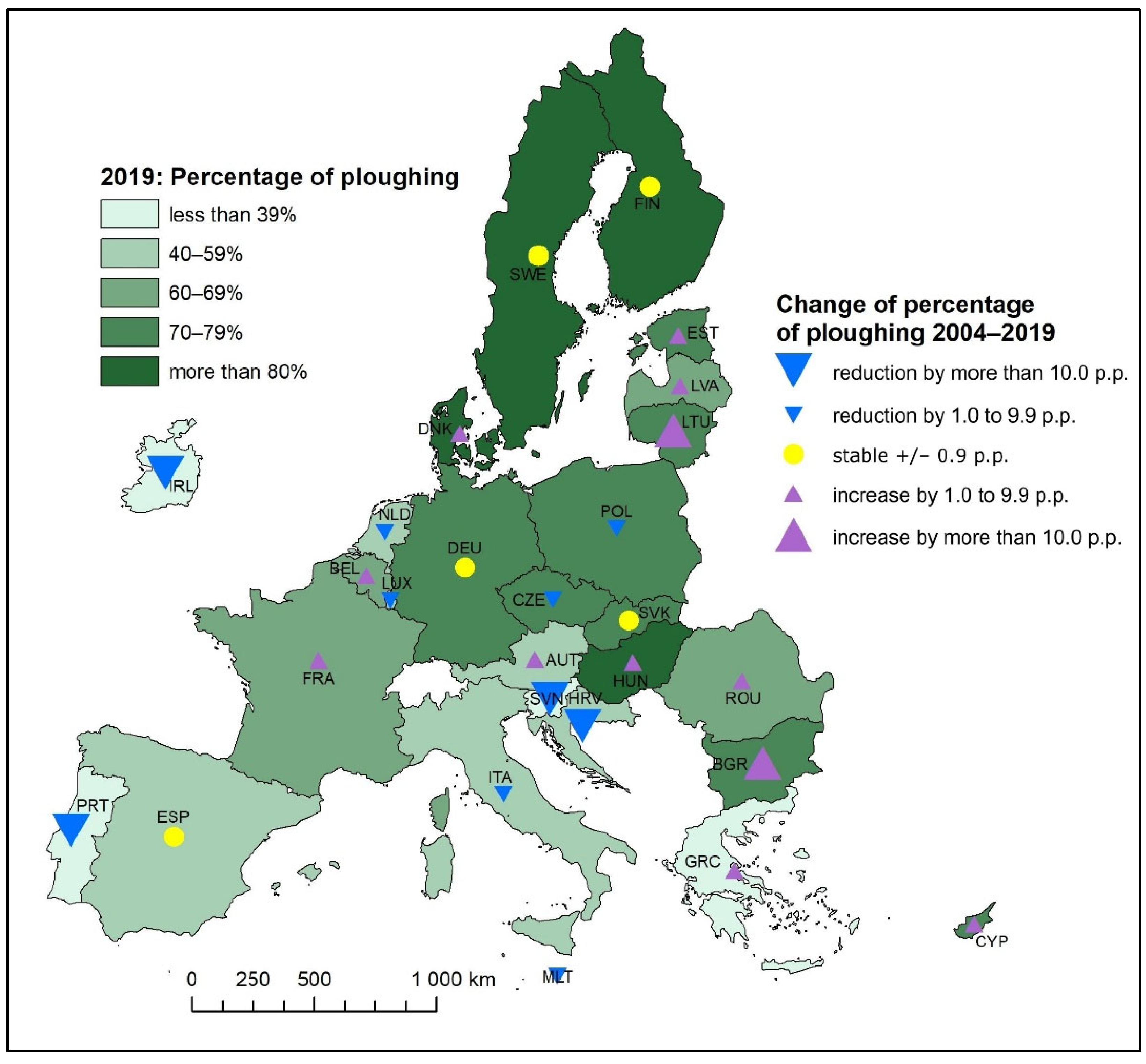
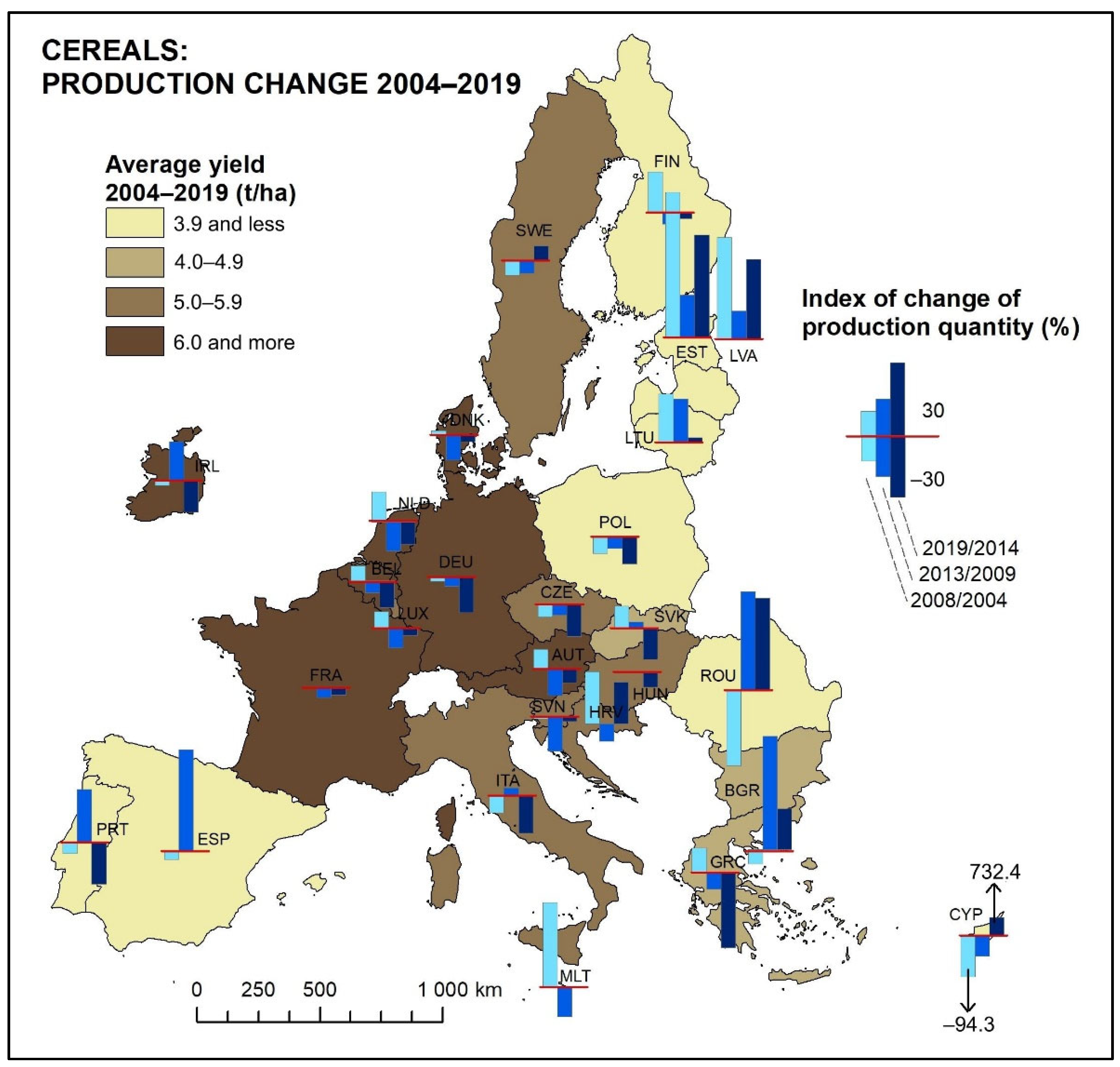
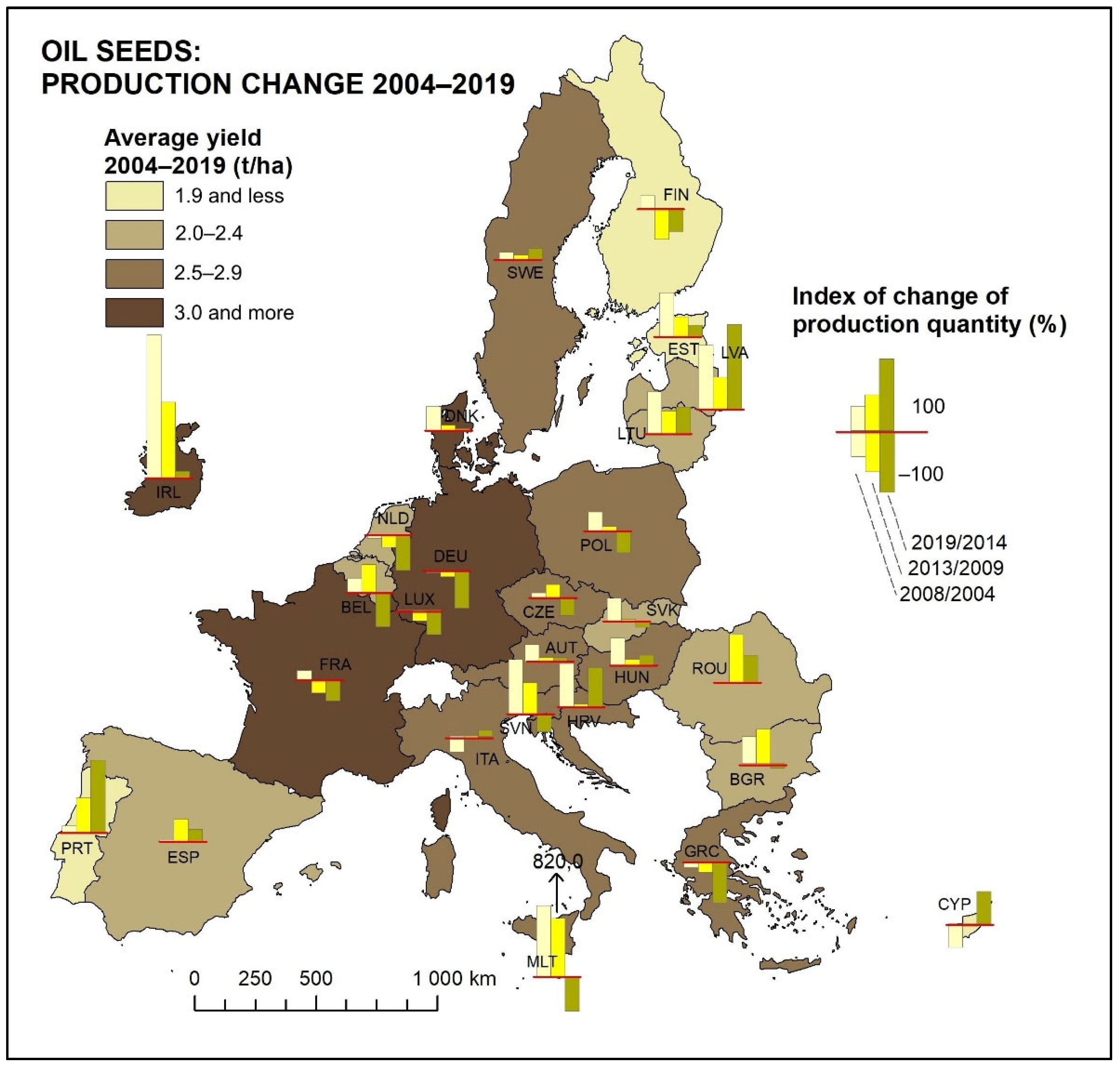
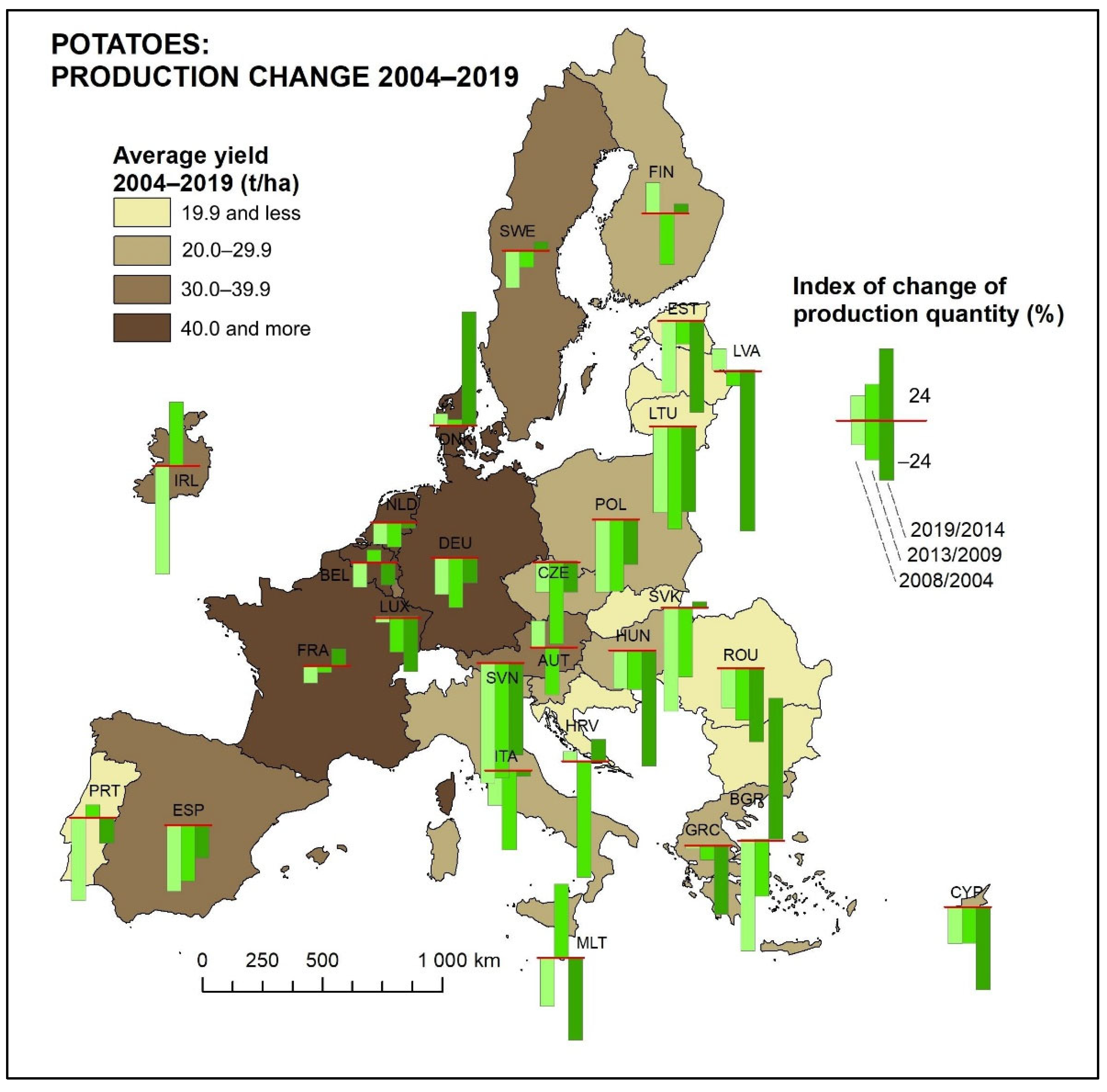
Publisher’s Note: MDPI stays neutral with regard to jurisdictional claims in published maps and institutional affiliations. |
© 2022 by the authors. Licensee MDPI, Basel, Switzerland. This article is an open access article distributed under the terms and conditions of the Creative Commons Attribution (CC BY) license (https://creativecommons.org/licenses/by/4.0/).
Share and Cite
Némethová, J.; Svobodová, H.; Věžník, A. Changes in Spatial Distribution of Arable Land, Crop Production and Yield of Selected Crops in the EU Countries after 2004. Agriculture 2022, 12, 1697. https://doi.org/10.3390/agriculture12101697
Némethová J, Svobodová H, Věžník A. Changes in Spatial Distribution of Arable Land, Crop Production and Yield of Selected Crops in the EU Countries after 2004. Agriculture. 2022; 12(10):1697. https://doi.org/10.3390/agriculture12101697
Chicago/Turabian StyleNémethová, Jana, Hana Svobodová, and Antonín Věžník. 2022. "Changes in Spatial Distribution of Arable Land, Crop Production and Yield of Selected Crops in the EU Countries after 2004" Agriculture 12, no. 10: 1697. https://doi.org/10.3390/agriculture12101697
APA StyleNémethová, J., Svobodová, H., & Věžník, A. (2022). Changes in Spatial Distribution of Arable Land, Crop Production and Yield of Selected Crops in the EU Countries after 2004. Agriculture, 12(10), 1697. https://doi.org/10.3390/agriculture12101697





